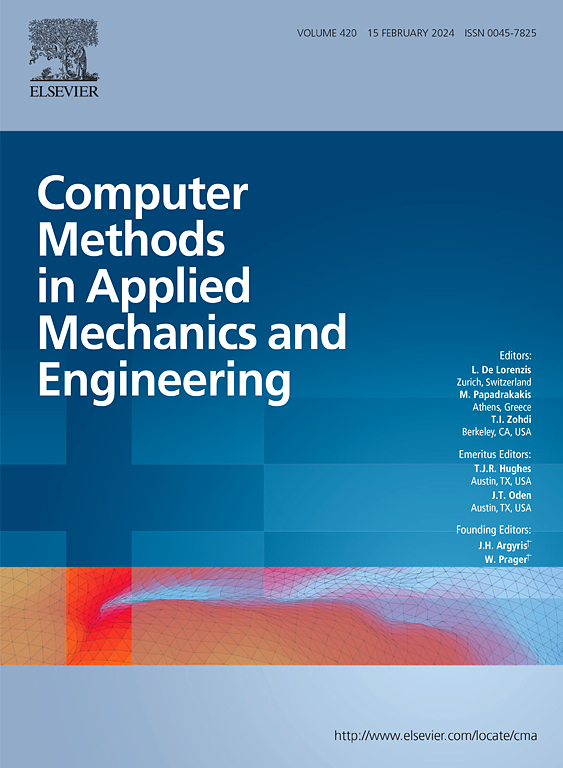A consistent diffuse-interface finite element approach to rapid melt–vapor dynamics with application to metal additive manufacturing
IF 7.3
1区 工程技术
Q1 ENGINEERING, MULTIDISCIPLINARY
Computer Methods in Applied Mechanics and Engineering
Pub Date : 2025-05-08
DOI:10.1016/j.cma.2025.117985
引用次数: 0
Abstract
Metal additive manufacturing via laser-based powder bed fusion (PBF-LB/M) faces performance-critical challenges due to complex melt pool and vapor dynamics, often oversimplified by computational models that neglect crucial aspects, such as vapor jet formation. To address this limitation, we propose a consistent computational multi-physics mesoscale model to study melt pool dynamics, laser-induced evaporation, and vapor flow. In addition to the evaporation-induced pressure jump, we also resolve the evaporation-induced volume expansion and the resulting velocity jump at the liquid–vapor interface. We use an anisothermal incompressible Navier–Stokes solver extended by a conservative diffuse level-set framework and integrate it into a matrix-free adaptive finite element framework. To ensure accurate physical solutions despite extreme density, pressure and velocity gradients across the diffuse liquid–vapor interface, we employ consistent interface source term formulations developed in our previous work. These formulations consider projection operations to extend solution variables from the sharp liquid–vapor interface into the computational domain. Benchmark examples, including film boiling, confirm the accuracy and versatility of the model. As a key result, we demonstrate the model’s ability to capture the strong coupling between melt and vapor flow dynamics in PBF-LB/M based on simulations of stationary laser illumination on a metal plate. Additionally, we show the derivation of the well-known Anisimov model and extend it to a new hybrid model. This hybrid model, together with consistent interface source term formulations, especially for the level-set transport velocity, enables PBF-LB/M simulations that combine accurate physical results with the robustness of an incompressible, diffuse-interface computational modeling framework.
快速熔气动力学的一致扩散界面有限元方法及其在金属增材制造中的应用
由于复杂的熔池和蒸汽动力学,通过基于激光的粉末床熔融(PBF-LB/M)进行金属增材制造面临着性能关键的挑战,这些挑战通常被计算模型过度简化,忽略了蒸汽射流形成等关键方面。为了解决这一限制,我们提出了一个一致的计算多物理场中尺度模型来研究熔池动力学、激光诱导蒸发和蒸汽流动。除了蒸发引起的压力跳跃外,我们还解决了蒸发引起的体积膨胀和由此导致的液-气界面速度跳跃。我们使用由保守扩散水平集框架扩展的非等温不可压缩Navier-Stokes解算器,并将其集成到无矩阵自适应有限元框架中。为了确保精确的物理解,尽管在弥漫性液-气界面上存在极端的密度、压力和速度梯度,我们采用了在我们以前的工作中开发的一致的界面源项公式。这些公式考虑投影运算,将溶液变量从尖锐的液-气界面扩展到计算域。包括膜沸腾在内的基准示例证实了该模型的准确性和通用性。作为一个关键的结果,我们证明了该模型能够捕捉PBF-LB/M中熔体和蒸汽流动动力学之间的强耦合,这是基于对金属板上固定激光照射的模拟。此外,我们展示了著名的阿尼西莫夫模型的推导,并将其推广到一个新的混合模型。这种混合模型,加上一致的界面源项公式,特别是水平集传输速度,使PBF-LB/M模拟能够将精确的物理结果与不可压缩、扩散界面计算建模框架的鲁棒性结合起来。
本文章由计算机程序翻译,如有差异,请以英文原文为准。
求助全文
约1分钟内获得全文
求助全文
来源期刊
CiteScore
12.70
自引率
15.30%
发文量
719
审稿时长
44 days
期刊介绍:
Computer Methods in Applied Mechanics and Engineering stands as a cornerstone in the realm of computational science and engineering. With a history spanning over five decades, the journal has been a key platform for disseminating papers on advanced mathematical modeling and numerical solutions. Interdisciplinary in nature, these contributions encompass mechanics, mathematics, computer science, and various scientific disciplines. The journal welcomes a broad range of computational methods addressing the simulation, analysis, and design of complex physical problems, making it a vital resource for researchers in the field.

 求助内容:
求助内容: 应助结果提醒方式:
应助结果提醒方式:


